Eat the peel: Why you might be throwing away the best bit of your fruit
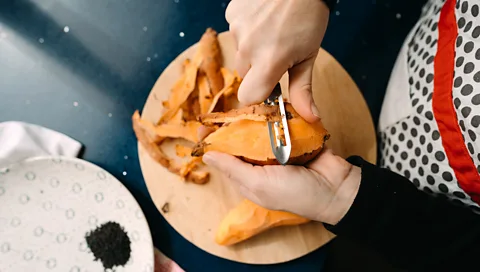 Getty Images
Getty ImagesInstead of throwing away edible and nutrient-rich peel of bananas, oranges and other fruits and veg, here are five ways to make the most of them.
It would be strange to needlessly throw away one third of the edible part of a banana every time you have one. But that's exactly what most of us do when we discard the peel, which makes up around one third of the average weight of the total fruit.
The peel of the banana, like many fruits and vegetables, is not only edible but contains useful nutrients. For an orange, around 20% of the fruit is peel – in 2018, around 15.1 million tonnes of orange peel was generated, according to one study (that's nearly 80,000 blue whales or 2,500 giant redwoods). For a kiwi, between 9-13% of the fruit is peel. For a pomegranate, there's almost as much peel as there are seeds.
Globally, about one third of food is lost or wasted, amounting to 1.3 billion tonnes per year. Food loss and waste accounts for 8% of global greenhouse gas emissions (more than triple aviation's contribution). Organic matter rotting in landfill sites also releases large amounts of methane, a potent gas 80 times more powerful than carbon dioxide (CO2) over a 20-year time span. Composting food waste instead of sending it to landfill can help reduce the amount of methane released into the atmosphere. But much of what we think of as waste is in fact perfectly edible.
Within the food industry, there's growing interest in making better use of both the nutrients and the energy in the peel that typically gets thrown away. But there are ways to do this at home too.
Perhaps one of the easiest ways to use up peel are recipes that call for all parts of the fruit, not just the flesh – such as a banana and peel breakfast loaf. Here are five more options for cooking with leftover scraps which are too often thrown away.
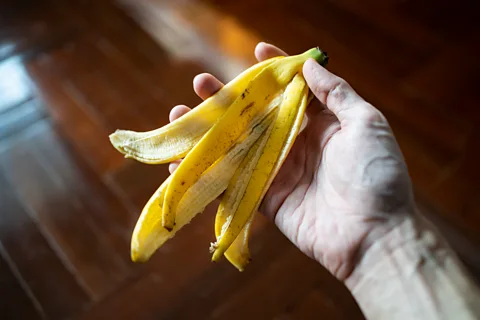 Getty Images
Getty ImagesOrange peel - Isabelle Gerretsen
After the Christmas holiday, I had a huge bowl of oranges left over, so I thought would try making marmalade for the first time. Marmalade is a breakfast staple in my house – I always start my day with a strong English breakfast tea and a slice of toast slathered in butter and the orange preserve. I found a recipe on BBC Good Food for the "English classic as made famous by Paddington Bear" which sounded nice and simple. There were just three ingredients: Seville oranges (1.3kg/2.9lb), the juice of two lemons and a frankly shocking amount of granulated sugar (2.3kg/5.1lb).
I quickly realised that making marmalade is not particularly fast or simple. It took me almost three hours to make two jars and involved quite a few steps, including two hours of simmering the oranges, straining the pulp through a sieve into the juice so that it releases pectin (a naturally occurring starch which helps the marmalade set). I then added in the sugar and the sliced peel and boiled the orange concoction for 20 minutes.
This clearly wasn't long enough, as while my marmalade looked and tasted great (neither too sweet nor too bitter), it remained very runny – not ideal for spreading on my toast. But I've discovered a lovely new breakfast option: marmalade with Greek yoghurt.
I had a couple of oranges left so I also decided to make candied orange peel, by chopping up peel and simmering it in boiling water for 10 minutes. You have to repeat this process three times and rinse the peels with cold water each time to remove the bitter flavour, before you mix in the sugar and water. The candied orange peel was delicious – the perfect sweet snack. I was also left with a tasty orange syrup which I've been using as a cordial in drinks.
I'm pleased that I've managed to transform my bowl of oranges into four tasty food items: marmalade, candied peel, a glass of juice and the orange syrup. An added bonus is that my kitchen smelled incredible – infused with a delicious orange aroma.
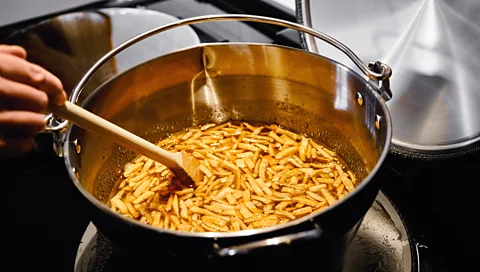 Getty Images
Getty ImagesPineapple peel - Lucy Sherriff
Eating a pineapple always feels so wasteful. There seems to be more waste from the core, rinds and top than there's actually fruit. This time I tried putting those rinds to use.
Tepache is an historic Mexican fermented beverage that dates back to pre-Hispanic times. Not only does it use all that waste, but it's also a source of probiotics. It's a fun – and easy – recipe to make, but be careful if you're avoiding alcohol because the fermentation process means there is some alcohol present (although usually less than 1%, depending on fermentation times – the longer you ferment the drink, the higher the alcohol content).
I used a one-gallon (3.8 litre) jar, a large elastic band, and a piece of muslin or cheesecloth that is big enough to cover the jar opening.
First I washed, peeled and cored one pineapple (an organic fruit lowers the risk of pesticide residues on the skin).
Then I combined water with brown sugar or piloncillo (a traditional unrefined cane sugar from Mexico), in a pan and slowly heated until sugar dissolved. Next, I let it cool slightly, and added the pineapple core and rinds into jar, and poured in the sugar and water mixture while it was still warm.
Then you cover it with muslin, a cheesecloth, dishtowel or kitchen paper – basically you want something to keep the flies out but let air in.
Next, I left the mixture to ferment. I was recommended to keep the tepache between 21-25C (70-78F), and to keep checking on it – after 24-36 hours you should white foam on the top which means it's fermenting. The longer you leave it – the stronger the flavour. Once it was ready, I strained the liquid and refrigerated for a refreshing drink.
Tip: You can add ginger, lime, and other fruits for extra flavour. (But if you're adding acid, like lemon or lime, don't add until the mixture is ready as it slows the fermentation process.)
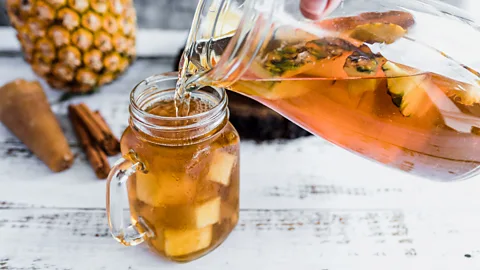 Getty Images
Getty ImagesGinger peel - Lucy Sherriff
Ginger peel, too, is frequently thrown away as food waste.
But it's the peel that gives ginger so many of its beneficial qualities: the peel contains bioactive compounds which have phytochemical properties that include antioxidant, antimicrobial, and anticancer effects. Ginger peel is a rich source of fibre and vitamins, including vitamin C, calcium, iron and others.
So if you're not going to discard the peel, how should you use it?
You can simply use the ginger as normal, with peel attached (in fact, very few recipes specifically say you should use peeled ginger), or you can use the peel in other recipes.
Throw them into a soup to add flavour (but remove before blending or serving). Boil them with water to create a ginger broth, which can be stored in the fridge and added to smoothies, juices, cocktails, sparkling water, or used to steam root vegetables to add an extra kick.
Or for a rich flavour, slow roast the peel in the oven and grind it to a powder (either using a blender with a small grinder attachment or a coffee grinder). You can use this powder to brew a delicious ginger tea – make sure you strain it once it's brewed. The powder can also be used as a spice in cooking and baking.
Tip: try using a teaspoon to peel ginger, rather than a peeler.
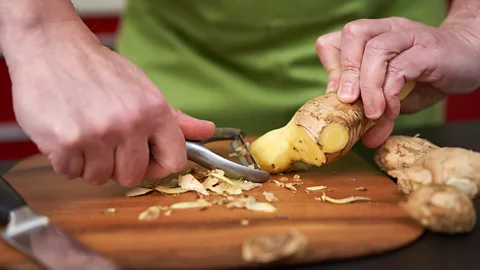 Getty Images
Getty ImagesButternut squash peel - Jocelyn Timperley
Many recipes call for winter squashes like butternut squash to be peeled before using, but the peel of all squashes is perfectly edible, as are the seeds. Both are a good source of fibre as well as vitamins and other bioactive compounds.
I usually leave the skin on butternut squash but throw away the seeds, as it seems too much of a hassle to have to clean them. But I wanted to try something different, so I decided to try roasting the skin and seeds to make some hopefully crunchy homemade crisps.
I started one evening as I was cooking dinner, using a butternut squash from my local veg box. I washed it thoroughly then dried it, then cut off the top and bottom. Next I used a vegetable peeler and knife to slither off as thin sections of the peel as I could manage (mainly the knife as the veg peeler didn't really work), which took about 10 minutes. I ended up with a mix of different sized pieces that looked ideal for bite-sized crisps.
Next, I cut open the butternut squash lengthwise and scooped out the seeds and surrounding mushy stringy pulp. I popped these and the peels in separate tubs in the fridge overnight, and used the peeled butternut squash to make a squash and paneer curry.
The next day when I was making coffee and feeling peckish, I separated the seeds from the pulp. I was dreading this part, but they actually came away very easily. I washed the seeds thoroughly then wrapped them up in a clean tea towel to dry. I then repeated this last step after my partner grabbed the tea towel to dry his hands and threw the seeds all over the kitchen floor…
I mixed the seeds and squash skin together in a bowl with some shakes of salt, paprika, smoked paprika, cumin and chilli flakes, then stirred in a few drizzles of olive oil. I cooked the lot using the bake/roast setting of my air fryer at 170C (338F) to avoid burning them and checked on them frequently. After about 20 minutes they were looking nice and crispy.
I was still a bit dubious at this point – but they were delicious. The smaller chips turned out the best as they were super crunchy, and the seeds had an amazing taste. I loved being able to choose which spices I put on them, but I think the ability to use a nice olive oil was what put these miles ahead taste-wise of bought crisps. They would also make a fantastic garnish for soup.
Overall, though, it did feel like a lot of hassle for not a lot of food. Next time I would make sure to separate and wash the seeds ahead of time, and I'd also check on them less now I know how long they need, making this an easier snack. It was useful to use the air fryer, as turning on a whole oven for this amount would feel like rather a waste of energy.
I did really enjoy the final result though, and found it really filling too, and I would definitely use it again for any time I can be bothered peeling a squash. For any tougher peels, it's also worth remembering the peel can be saved in a bag in the freezer along with other edible vegetable leftovers and used to make vegetable stock.
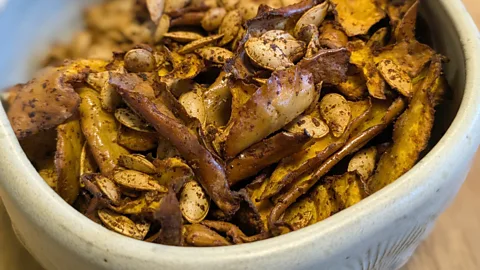 Jocelyn Timperley
Jocelyn TimperleyOnion peel - Francis Agustin
The papery skin of an onion is another outer peel we don't typically think twice about before discarding.
I had seen people on social media drying out their onion scraps and grinding them into an onion powder, so I decided to try replicating it. I set aside a portion of the dry outer layer of yellow onion skins for the "powdering".
In short, after a few hours of oven-drying some onions, then throwing them into a food processor, the outcome was disappointing. I ended up adding salt to boost the flavour and then throwing the resulting mixture into a general spice rub where the onion taste was subdued.
 Francis Agustin
Francis AgustinAs I had a few more onion skins left, I took a swing in an entirely different direction.
Like many peels or skins, onions contain chemicals called flavonoids, which have antioxidant and anti-inflammatory properties. These flavonoids can be boiled and extracted from the vegetable, producing a potent coloured dye. Tannins (the same type of molecules that give wine a dry taste) are also found in the onion's flaky outer layer, its bitter taste deterring hungry critters. But the same way tannins make wine stains a pain to remove, the tannins in onions make an effective dye for fibres like cotton and linen, which typically need to be primed with a fixative called a mordant to ensure the dye lasts.
First, I washed the fabric (I used a clean sock) in a warm water bath to remove any lingering oil or dirt, which could impede the effectiveness of the dye.
After airdrying the fabric, I tossed the onion skins into a large metal pot with about two cups of water (adjust dye and water amounts depending on how big the fabric is). On a medium flame, bring the skins to a boil, and keep the solution at a rolling boil for about 15 minutes, until the water turns a dark amber colour.
When the fabric is mostly dry, turn off the flame and remove the onion skins with a slotted spoon. Submerge the fabric into the hot dye solution so that it is totally covered and leave for 30 minutes to an hour. Without wringing out the fabric, leave it in a cool area to dry. If the amber colour of the fabric isn't strong enough, repeat the submerging process until reaching the desired colour.
I was pleasantly surprised at what this experiment led to, and plan to try it again. My sock came out an autumnal orange colour, but with the use of different types of onions or mordants, fabrics can come out anywhere from a bright mustard yellow to a muted pine green.
--
For essential climate news and hopeful developments to your inbox, sign up to the Future Earth newsletter, while The Essential List delivers a handpicked selection of features and insights twice a week.
